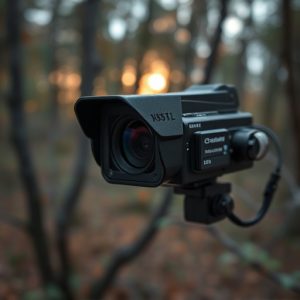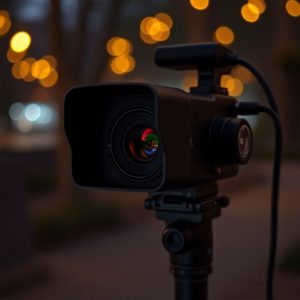Mastering Invisible IR Camera Location for Home Monitoring
Wireless surveillance systems, particularly Invisible IR Cameras designed for home monitoring, utili…….
Wireless surveillance systems, particularly Invisible IR Cameras designed for home monitoring, utilize infrared technology (IR) and wireless networks for low-light visibility and data transmission. Key specifications such as operating frequencies (2.4 GHz or 5 GHz), field of view, resolution, and battery life are crucial for accurate location detection. Optimal placement involves strategic positioning near windows, line-of-sight access, and regular testing. Environmental factors like obstructions and conditions impact signal strength and visibility, necessitating minimal obstructions and optimal storage conditions. Invisible IR Camera Home Monitoring systems, enhanced by multi-sensor fusion techniques, offer discreet, effective, and precise surveillance for continuous security and privacy protection.
Wireless surveillance equipment, particularly invisible IR cameras for home monitoring, offers unparalleled peace of mind. To maximize their effectiveness, understanding the technology and strategic placement are key. This article delves into the fundamentals of wireless surveillance, exploring the power of infrared (IR) technology for optimal home monitoring. We’ll guide you through effective placement strategies, environmental considerations, and advanced techniques to enhance detection, ensuring reliable location tracking with your invisible IR camera.
- Understanding Wireless Surveillance Equipment: A Foundation for Effective Location Detection
- The Power of Infrared (IR) Technology in Home Monitoring
- Placement Strategies for Optimizing Invisible IR Camera Performance
- Environmental Considerations: Ensuring Reliable Location Tracking
- Advanced Techniques to Enhance Wireless Surveillance Equipment Detection
Understanding Wireless Surveillance Equipment: A Foundation for Effective Location Detection
Wireless surveillance equipment, like Invisible IR Cameras for home monitoring, relies on specific technologies to capture and transmit footage. Understanding these devices is fundamental when attempting to accurately detect their location. These cameras, often discreetly placed, utilize infrared (IR) light to see in low-light conditions and wireless networks to transfer video data.
Knowing the operating frequencies of these systems—typically in the 2.4 GHz or 5 GHz bands for Wi-Fi—can aid in pinpointing their whereabouts. Additionally, understanding the field of view, resolution, and battery life of different models allows users to interpret signals and visual feedback more effectively. This knowledge acts as a foundation for successful location detection, ensuring optimal coverage and minimal interference during surveillance.
The Power of Infrared (IR) Technology in Home Monitoring
Infrared (IR) technology has emerged as a powerful tool for home monitoring, offering a level of discretion and effectiveness that traditional cameras can’t match. Invisible IR cameras are specifically designed to capture thermal energy emitted by objects, making them ideal for covert surveillance and night-time observations. Unlike visible light cameras that rely on reflection, IR cameras penetrate darkness, allowing users to monitor activities without being detected.
The versatility of IR technology lies in its ability to provide clear images even in complete blackness, thanks to the heat signature of living beings and objects. This makes it an excellent choice for home security systems, providing continuous monitoring without compromising privacy. With their non-intrusive nature and advanced sensitivity, invisible IR cameras offer a silent guardian for any household, ensuring peace of mind around the clock.
Placement Strategies for Optimizing Invisible IR Camera Performance
To optimize the performance of an invisible IR camera for home monitoring, strategic placement is key. These cameras are designed to capture heat signatures, making them ideal for night-time or low-light surveillance. Positioning them in hidden yet strategic locations ensures maximum effectiveness. Consider placing the cameras near windows or glass doors to take advantage of natural light and reflectivity, enhancing their ability to detect heat sources. Additionally, mounting them at eye level or slightly elevated positions allows for a broader field of view, covering more ground.
Invisible IR cameras perform best when they have line-of-sight access to the areas being monitored. Avoid obstructing their view with large objects or foliage. Ensure the lenses are clean and free from debris for optimal clarity. Regularly testing different placement strategies can help fine-tune the system, ensuring it captures high-quality images and effectively protects your home around the clock.
Environmental Considerations: Ensuring Reliable Location Tracking
When setting up wireless surveillance equipment for location detection, environmental factors play a significant role in ensuring reliable tracking. One crucial consideration is the use of an invisible IR (Infrared) camera designed for home monitoring. These cameras are particularly effective outdoors as they can capture clear images even in complete darkness, thanks to their infrared illumination. However, natural elements like trees, buildings, or weather conditions might interfere with the signal strength and visibility. To mitigate these issues, position the cameras strategically, ensuring minimal obstructions and a direct line of sight to the target area.
Additionally, environmental conditions can impact wireless signals. Temperature variations, humidity, and even wind can affect the performance of surveillance equipment. For optimal results, consider storing and operating the devices in suitable conditions, as specified by the manufacturer. Regular maintenance and cleaning are also essential to keep the equipment in top shape, ensuring consistent and accurate location tracking over time.
Advanced Techniques to Enhance Wireless Surveillance Equipment Detection
In the realm of wireless surveillance, enhancing detection techniques is paramount for effective security measures. Advanced technologies such as thermal imaging cameras, specifically Invisible IR Cameras, offer unprecedented capabilities in home monitoring. These devices detect heat signatures, allowing for invisible and unobtrusive observation, especially during night-time operations. By leveraging this technology, security professionals can uncover hidden activities or intrusions that might otherwise go unnoticed.
Additionally, integrating sophisticated location detection methods ensures precise identification of surveillance equipment. This involves utilizing multi-sensor fusion techniques, combining visual feeds from CCTV cameras with radio frequency (RF) signal tracking and geospatial data. Such comprehensive approaches make it possible to pinpoint the exact locations of wireless devices, even in complex environments or when traditional GPS methods fail, enhancing overall security and privacy protection.
Wireless surveillance equipment, especially the invisible IR camera for home monitoring, offers unparalleled security through advanced technologies like infrared sensing. To maximize its effectiveness, strategic placement and careful consideration of environmental factors are key. By understanding the nuances of this technology and employing optimal location detection tips, users can ensure reliable tracking and enhanced security in their homes. Advanced techniques further bolster these systems’ capabilities, making them indispensable tools for modern home monitoring.


